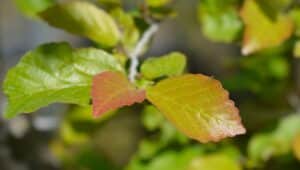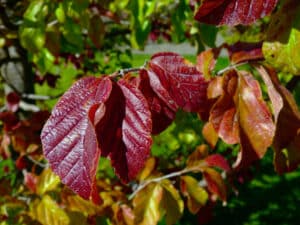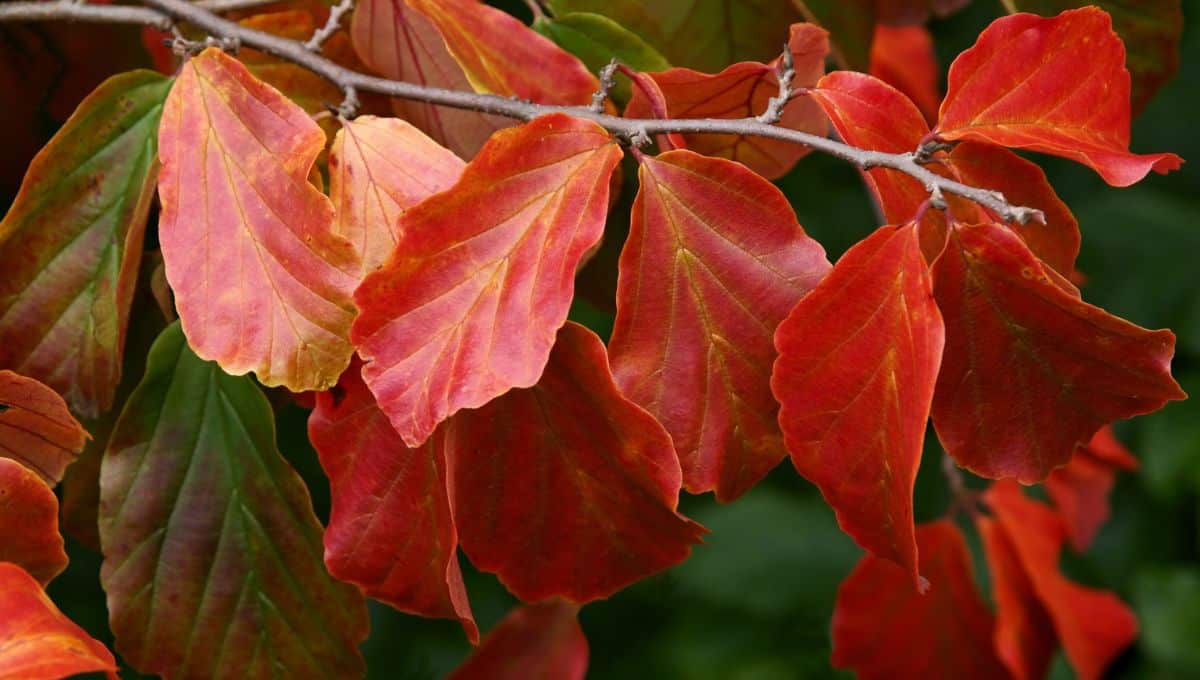If you are looking for a showy landscape tree that is both hardy and drought-tolerant, Parrotia persica is a perfect choice. This deciduous tree grows to 40 feet with an upright branching habit. The leaves are a deep green and turn shades of yellow and red in the fall. In late winter/early spring, Parrotia persica produces clusters of fragrant red flowers that bees love. Best of all, this tree thrives in dry conditions and is resistant to pests and diseases.
Parrotia Persica is an excellent addition to any garden. In this blog post, we’ll take you through an in-depth of this plant, from its plantation to caring. We’ll also share some of the most commonly asked questions about this plant. So, let’s dig into it.
Parrotia Persica Tree Vs Parrotia Persica Hedge
Parrotia Persica Tree
Parrotia persica, also known as the Persian ironwood tree, is a deciduous tree native to Iran and Afghanistan. It typically grows to 20-30 feet and has a broad, round canopy. The bark is smooth and gray, while the leaves are dark green and oval. The flowers are small and red, and the fruit is a small, fleshy drupe. The Persian ironwood tree is prized for its ornamental value and has been used in landscape designs for centuries. It is also valued for its timber, which is solid and durable.
Parrotia Persica Hedge
The Parrotia Persica Hedge is a beautiful addition to any garden. It’s hardy and can thrive in most climates, making it a perfect choice for anyone looking for a low-maintenance hedge. The Parrotia Persica Hedge also has lovely fall foliage, making it an excellent choice for homeowners who want to add some color to their landscape in the autumn months. Its dense growth habit also makes it a good choice for privacy hedges and windbreaks. In addition to its attractive foliage, the Parrotia Persica Hedge is also known for its fragrant flowers, which can be found blooming in late winter and early spring.

Where and When to Plant Parrotia Persica?
Parrotia Persica can be planted during the springtime when the temperature ranges from 50-85 degrees Fahrenheit. The plant prefers well-drained soil, so make sure to amend your soil before planting. Water regularly until the plant is established.
When planting Parrotia Persica, dig a hole twice as wide and deep as the rootball of the plant. Place the plant in the hole and backfill it with soil, making sure to press down gently to remove any air pockets. Water deeply after planting and mulch around the plant to help keep moisture in the ground. With proper care and a suitable climate, your Parrotia Persica should be a beautiful addition to your garden.
How To Care For a Parrotia Persica Tree
To care for a Parrotia persica, you will need to provide plenty of water and fertilizer. Not only that, you need to walk some extra steps in case you want to have a nice and beautiful plant for your home. Here are some tips on how to care for a Parrotia persica or ironwood:
- Water your Parrotia persica tree regularly, keeping the soil moist but not wet.
- Provide mulch around the tree’s base to retain moisture and reduce weeds.
- Fertilize once a year in the spring with a balanced fertilizer.
- Make sure to prune the tree regularly to keep it healthy and to look its best.
- It can tolerate light to medium shade but will do best in a sunny spot.
- Prune as needed to keep the tree shapely.
- This tree may benefit from winter protection, such as a burlap wrap or a plastic tree guard if you live in an area with cold winters.
- Protect the Parrotia persica from strong winds and hot sun.
- Remove any dead, diseased, or damaged branches immediately.
- Inspect the bark regularly for signs of pests or diseases, and treat any problems as soon as possible.
- Keep the area around your Parrotia persica tree free of weeds and debris to help prevent diseases and pests.
These are some best tips for ironwood for better growth. With proper care, your Parrotia persica tree can thrive for many years.
What are Some Parrotia Persica Problems?
Parrotia persica is a plant that is susceptible to a number of problems, chief among them being pests and diseases.
Pests commonly affecting Parrotia persica include aphids, scales, nematodes, and beetles. These can cause damage to the leaves, flowers, and branches. In addition, Parrotia persica is also susceptible to several diseases, such as bacterial canker, leaf spot, and powdery mildew. These problems can cause significant damage to the plant and may lead to its death.
To prevent these issues, it is important to provide adequate care and nutrition for the plant and regularly inspect the plant for signs of damage or disease. If any injury or disease is found, it is important to take immediate action to prevent the further spread or death of the plant.

What are the Benefits of Parrotia Persica?
The Benefits of Parrotia Persica include its anti-inflammatory, anti-fungal, and antioxidant properties. It is also a source of vitamin C and other nutrients. It has been used as a traditional remedy in Iran for centuries to treat various illnesses, including colds and flu. Its leaves have also been used to make herbal tea. Additionally, it has been used as a natural dye and as a natural insect repellent.
Parrotia Persica is an excellent choice for gardens and landscapes as it provides a lovely, vibrant display of reds and oranges in the fall. It is also widely used in bonsai and other ornamental plantings. It is a resilient tree that requires minimal maintenance, making it an ideal choice for busy gardeners. Parrotia Persica is also known for its resilience against drought and pests, making it an excellent choice for areas that experience extreme weather conditions.
FAQs on Parrotia Persica
How Fast Do Persian Ironwood Trees Grow?
Persian ironwood is a medium to fast growth rate for a deciduous tree. These trees can grow up to 24 inches a year and typically reach an average height of 20 to 30 feet, although some can reach up to 40 feet. These trees have a moderate growth rate, meaning they can reach a mature size within ten years with proper care and growing conditions.
How To Prune Persian Ironwood?
Pruning a Persian ironwood tree is best done in late winter or early spring before new growth begins. Use sharp pruning shears to cut branches back to lateral buds. Make cuts at a 45-degree angle above the bud, angling away from the trunk. Always clean and disinfect your pruning tools after each use with a household cleaner or rubbing alcohol to prevent the spread of disease.
Can I Plant Parrotia Persica In The Uk?
Yes, Parrotia persica can be planted in the UK. This tree is hardy in zones 4-8 and grows best in full sun to partial shade. This tree is quite adaptable to soil types and can easily survive in various conditions. This is why you can easily plant Parrotia persica in the UK.
Is Parrotia Persica Poisonous To Dogs?
No, Parrotia Persica is not poisonous to dogs.
Where Can I Buy Parrotia Persica?
You can buy Persian ironwood at many online and physical stores that carry gardening supplies. You can also find it by doing a simple Google search. Or you can buy it here: Parrotia persica

